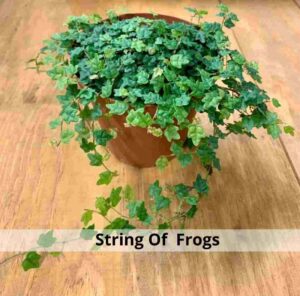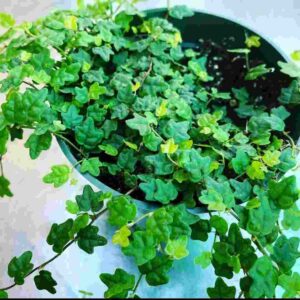Looking to add some new life to your garden? A string of frogs may be the perfect addition! These little guys are easy to care for, and they can brighten up any space. In this guide, we will provide everything you need to know to get started with a growing string of frogs. We’ll discuss what type of soil and water they need, how much light they require, and more!
Introduction
The string of frogs is a creeping plant with tiny oak shaped leaves which resembles the shape of frogs. It is a tropical, evergreen and perennial liana native to southeast asia regions like other Ficus genus. It has dark green leaves attached to its tendrils which need support to expand and climb. It is a non-flowering plant grown from its absolutely stunning foliage beauty. It is grown both indoors and outdoors but mostly kept indoors in a hanging basket. It can also be placed next to the wall to let it expand by climbing on the wall. It can grow to a height of about 3m and can spread about 5m wide. This houseplant is toxic to childrens and pets. This species of Ficus is quite rare among other varieties. It is a non-invasive plant also called Oak leaf creeping fig. It is grown in USDA hardiness zones 9-11.

The string of frogs is a creeping plant with tiny oak shaped leaves which resembles the shape of frogs. It is a tropical, evergreen and perennial liana native to southeast asia regions like other Ficus genus.
It is scientifically called Ficus pumila ‘Quercifolia’ also called Ficus thunbergii. Quercus is the Latin for oak, and folia from the Latin word folium means leaf. Put those together and we have Quercifolia: the oak leaf ficus. Ficus quercifolia is a great terrarium plant. It’s a small leafed and slower growing version of Ficus pumila, also known as the creeping fig. Given time it will become ground cover or a background plant though it will take a lot longer to grow than Ficus pumila. some general info about this plant is tabulated below:-
| Plant Name | String Of Frogs |
| Other Name | Oak Leaf Creeping Fig |
| Scientific Name | Ficus quercifolia |
| Origin | Southeast Asia |
| Growing Zone | USDA Hardiness zone 9-11 |
| Grown For | Foliage |
| Plant Type | Tropical, Perennial and Evergreen Liana |
| Height | 3 m |
| Width | 5 m |
| Tolerance | Drought tolerant, Deer resistant, Salt tolerant |
| Toxicity | Toxic To Children And Pets |
| Price | $10 to $40 |
Variegated String Of Frogs
The Ficus pumila are variegated with a wide white margin on their leaves clustered in wiry stems. Ficus quercifolia are the miniature and oak shaped leaf version of Ficus pumila which are variegated in a similar way.
Is It Toxic To Animals?
It is toxic to your childrens and pets like cats and dogs even if the plant appears to be safe, which you should bear in mind. Almost all of the plants belonging to the Moraceae family are poisonous when applied to the skin. The sap from a frog’s string may induce phytophotodermatitis, an inflammation of the skin caused by exposure to plant sap. In severe cases, this can lead to blistering and burns. If you have pets or children, it is best to keep them away from the plant.
Symptoms of Poisoning
If your pet or child ingests any part of the string of frogs plant, they may experience the following symptoms:
- Vomiting
- Diarrhoea
- Skin inflammations
- Drooling
- Abdominal pain
- Dermatitis and redness of skin
- Tremors
- Seizures
If you suspect that your pet or child has ingested any part of the string of frog plants, it is important to seek medical attention immediately.
Botanical Classification
| Kingdom | Plantae |
| Clade | Tracheophytes |
| Clade | Angiosperms |
| Clade | Eudicots |
| Clade | Rosids |
| Order | Rosales |
| Family | Moraceae |
| Tribe | Ficeae |
| Genus | Ficus |
| Species | quercifolia |
Propagation

String of frogs can be propagated easily by stem cuttings, leaf cuttings and seeds.
1. By stem cuttings:
1. To propagate by stem cuttings, take a 6-8 inch cutting from a healthy plant and remove the lower leaves.
2. Dip the cutting in rooting hormone and plant in a pot filled with a well-draining potting mix.
3. Water lightly and place the pot in a warm, bright location out of direct sunlight. Keep the soil moist but not wet and roots should form within 4-6 weeks.
4. Once the roots are well established, you can transplant the cutting into a larger pot or into the garden.
2. By leaf cuttings:
1. To propagate by leaf cuttings, take a single leaf from a healthy plant and snip off the petiole (leaf stalk).
2. Plant the leaf in a pot filled with well-draining potting mix and water lightly.
3. Place the pot in a bright, warm location out of direct sunlight and keep the soil moist but not wet.
4. New plants will form at the base of the leaf over time and can be transplanted once they are large enough to handle.
3. By seeds:
String of Frogs plants can also be propagated by seed, but this is a more difficult method.
1. To propagate by seed, sow the seeds in a pot filled with well-draining potting mix.
2. Place the pot in a warm, bright location out of direct sunlight.
3. Keep the soil moist but not wet and seedlings should appear within a few weeks.
4. Once the seedlings are large enough to handle, transplant them into individual pots or into the garden.
Care

Taking care of this plant is easy enough and does not require any special skills. For convenience, let’s divide the care of String of Frogs into several categories.
Light
This plant requires a lot of bright or partial indirect sunlight. If you live in a region with harsh sunlight, it is best to provide some shade for your plant. The ideal temperature for this plant is between 70 and 85 degrees Fahrenheit.
Temperature
It’s a tropical plant so try not to let the temperatures dip below 10 degree celsius or 50 degrees Fahrenheit. That will cause the plant to go into a dormant state and stop growing. It can tolerate temperatures up to 95 degrees Fahrenheit.
Soil
The plant prefers well-draining, sandy soil. If your soil is heavy or clay-like, you can mix in some perlite or sand to improve drainage. The soil should be moist but attention should be given not to keep it wet for a long time. The soil condition can be analysed by dipping the forefinger 2cm deep into the potting mix.
Mixing the perfect soil recipe is essential for any gardener hoping to achieve success with their plants. But what exactly should go into the perfect soil mix? For the String of Frogs plant, a good mix should include ingredients that help to retain moisture, such as peat moss or coco coir/Cocopeat. Perlite or vermiculite can also be added to help improve drainage. In addition, be sure to add a slow-release fertiliser to provide the plant with the nutrients it needs to grow. By following these guidelines, you can create a mix that will help your String of Frogs plant thrive.
Water
This plant does not like to sit in wet soil, so it is important to water it only when the soil is dry. When watering, be sure to soak the entire root ball. Allow the excess water to drain away before putting the plant back in its pot. During the winter months, you can reduce watering to once every two weeks. Overwatering may lead to root rot so stagnant water should be drained out as soon as possible.
Humidity
The plant prefers a humid environment, but it can tolerate dry conditions. If the air in your home is too dry, you can mist the plant with water or place it on a pebble tray.
Fertilisers
Fertilisers are not strictly necessary, but you can feed your plant once a month with diluted liquid fertiliser.
Potting And Repotting
To pot or repot your plant, simply remove it from its current pot and replant it in a new one that is slightly larger. Be sure to use well-draining soil, shake out old soil, remove unwanted branches and water the plant thoroughly after repotting.
Trimming And Pruning
Trimming and pruning are not necessary, but you can remove any dead or damaged leaves. If you want to encourage bushier growth, you can pinch back the tips of the stems.
Common Problems
The most common pests infection are caused by spider mites, mealybugs and scale.
- They damage the foliage beauty and leach out the nutrients.
- Mealy bugs which appear as a cotton-like substance underside of leaves may cause leaf curling, falling and yellowing.
- Scales produce some sticky excrement on the leaves leading to scorched leaves.
- Spider mites create silky webs around plants turning leaves yellow and brown.
The infected plant is treated by knocking down the pests using strong blast of water, scraping off, dabbling with a cotton ball dipped in alcohol, using neem oil, insecticidal soap, etc.
String Of Frogs Plant Turning Brown
If your plant is turning brown, it is likely due to too much direct sunlight. Move the plant to a location with bright, indirect sunlight. If the leaves are still brown after a few days, you can remove them. Brown leaves will not recover, so it is best to remove them from the plant.
Price
String of Frogs plants are not expensive, and they are widely available. You can find them at your local nursery or online. Prices vary depending on the size and condition of the plant. The general price of String Of Frogs plant is 10 to 40 $.
Pros
- It’s a low maintenance plant suitable for beginners.
- It can be used to decorate a wall, ground or hanging basket.
- It’s cheaper since no extra resources like fertiliser are required.
- It doesn’t require any special techniques to grow.
Cons
- It’s toxic to pets.
- Its leaves get damaged easily in strong light.
- The pest infestation is difficult to identify due to clusters.
Final Verdict
If you’re looking for a low-maintenance plant to add to your collection, you might be thinking about getting a string of frogs. The string of frogs also don’t mind being pot bound, so they’re perfect for beginners.
However, there are a few things to keep in mind before you buy one. First, a string of frogs is toxic to pets, so if you have cats or dogs, this might not be the plant for you. Additionally, they can be susceptible to mealybugs and other pests. But as long as you keep an eye out for problems, a string of frogs can make a great addition to your home.
The String of Frogs is a beautiful, easy-to-care-for plant that makes a great addition to any home. With its cascading stems and unusual leaves, this plant is sure to turn heads.

